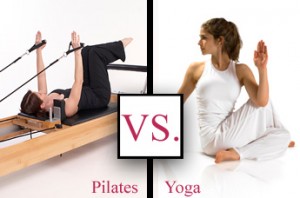 As a Pilates professional I am often asked to explain the difference between pilates and yoga.
As a Pilates professional I am often asked to explain the difference between pilates and yoga.
I came across this excellent post by Kathy Smith and thought she did a great job explaining the benefits of each practice as well as the differences. As I know many of our clients do yoga in addition to their workouts at Pilates1901, I welcome your feedback and response to this discussion. Feel free to leave your comments below.
When people speak of the physical benefits of exercise, they tend to focus on the three S’s: strength, stamina and slimming. With this in mind, their training programs usually consist of weight lifting to build muscle, with some form of aerobic activity to build cardiovascular endurance and burn calories. But there’s a second tier of benefits we’re starting to value. These include flexibility, coordination, posture and stress relief.
It’s not that these secondary benefits weren’t always important — it’s just that they’re more in the spotlight these days thanks to the growing popularity of so-called “softer” training modalities. Two of the most popular of these are yoga and Pilates.
Yoga, of course, has been popular in the U.S. for decades. Kathy started practicing yoga more than 20 years ago and it’s still one of her favorite ways to tone her body and calm her mind. Pilates though is a newer trend that apparently still has many people baffled. She often get letters inquiring about the difference between Pilates and yoga and asking which she recommends. As with most questions, the answer depends on your individual physical goals. Simply put, the difference between yoga and Pilates is that between East and West. Both systems build strength and flexibility; the difference between them is not so much physical as it is philosophical.
A Tale of Two Workouts: Yoga and Pilates
Let’s take yoga first. Yoga is based on the Eastern idea of moving energy through your body. The more freely the energy flows, the healthier and more energetic you feel. Physical tension hinders the flow; over time, areas of tension in your body can become tight and rigid, even painful. The goal of yoga is to keep the body supple through movement and stretching. But there’s another dimension. Yoga is a holistic spiritual discipline with its roots in Eastern forms of meditation. The physical postures, although they condition the body, are really aimed at the mind. They symbolize the goal of living your life in a state of balance and composure. When you spend an hour in a yoga class, you might melt into a kind of meditative state and emerge wonderfully relaxed and refreshed.
Pilates on the other hand is physical conditioning first and foremost — and there’s nothing quite like it. Its creator, Joseph Pilates, was looking for a way to rehabilitate injured soldiers after World War I. He developed an assortment of curious machines with names like the “Reformer” and the “Cadillac.” Using cables and trolleys and unusual body positioning, Pilates exercises stretch and strengthen and are unique in their ability to encourage coordination between the muscles that stabilize the body.
How does Pilates Reformer Training differ from Yoga?
Pilates techniques quickly became a hit with dancers, who found them a highly effective way to improve body awareness and alignment and promote graceful, fluid motion. Machine-based Pilates actually has more in common with weight training than with yoga since it involves moving against resistance (provided by springs) with the aim of overloading the muscles. In particular it resembles functional strength exercises such as squats or cable pulls. There’s also a form of Pilates, the Pilates mat class, which relies more on callisthenic-style exercises and stretches. This form is physically more similar to a yoga class though the emphasis is still on physical change rather than on spiritual development through postures and breathing.
The Choice Is Yours
Generally speaking, it may be fair to say yoga is more about how it makes you feel while Pilates is about how you look — how you carry yourself and move. So if you’re looking for a limbering, rejuvenating workout that will provide as much of a lift for your brain as your body — and you’re not too concerned about building muscle –Kathy recommends yoga. If you’re interested in a more dynamic system of muscle conditioning — or if you just want to try something new and different — Pilates may be the answer
In fact, it doesn’t have to be an either-or choice. After all, no single training system can give your body all the types of conditioning it needs. Mixing it up is often the most effective path to improvement! Pilates, running, dancing, yoga, cycling- it’s all good!
For more information on Pilates mat or reformer training, call Tina at 913 499 7510 today!

Leave a Reply